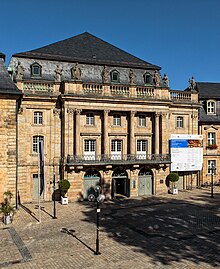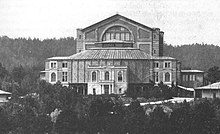Bayreuth | |
|---|---|
 Town square | |
show Location of Bayreuth | |
| Coordinates: 49°56′53″N 11°34′42″ECoordinates: 49°56′53″N 11°34′42″E | |
| Country | Germany |
| State | Bavaria |
| Admin. region | Upper Franconia |
| District | Urban district |
| Government | |
| • Lord mayor (2020–26) | Thomas Ebersberger[1] (CSU) |
| Area | |
| • Total | 66.92 km2 (25.84 sq mi) |
| Elevation | 340 m (1,120 ft) |
| Population (2021-12-31)[2] | |
| • Total | 73,909 |
| • Density | 1,100/km2 (2,900/sq mi) |
On 17 April 1870 Richard Wagner visited Bayreuth, because he had read about the Margrave Opera House, whose great stage seemed fitting for his works. However, the orchestra pit could not accommodate the large number of musicians required, for example, for the Ring of the Nibelung and the ambience of the auditorium seemed inappropriate for his piece.[7] So, he toyed with the idea of building his own festival hall (the Festspielhaus) in Bayreuth. The town supported him in this project and made a piece of land available to him, an undeveloped area outside the town between the railway station and Hohe Warte, the Grüner Hügel [de] ("Green Hill"). At the same time Wagner acquired a property at Hofgarten to build his own house, Wahnfried. On 22 May 1872 the cornerstone for the Festival Hall was laid and, on 13 August 1876, it was officially opened (see Bayreuth Festival). Planning and construction were in the hands of the Leipzig architect, Otto Brückwald, who had already made a name for himself in the building of theatres in Leipzig and Altenburg.








沒有留言:
張貼留言
注意:只有此網誌的成員可以留言。